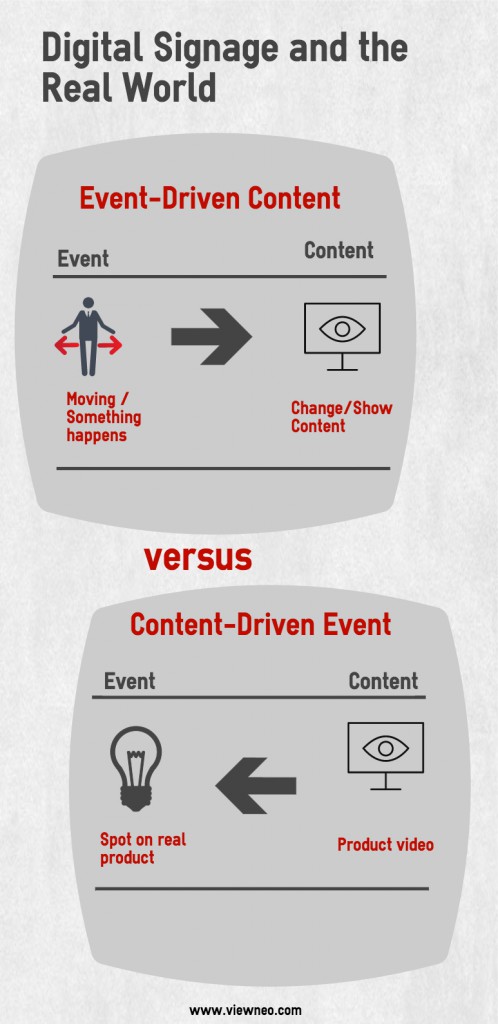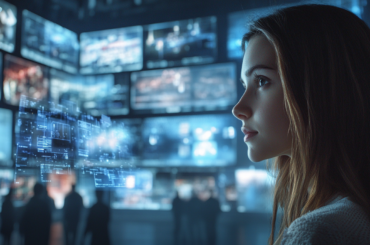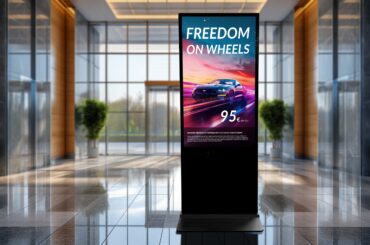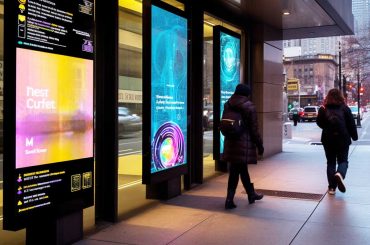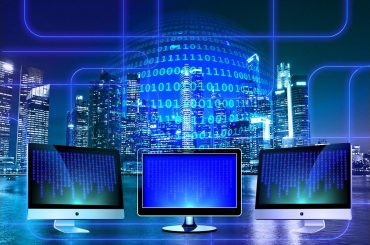Event-Driven Content with Digital Signage & IoT
The digital signage sector is still dealing with the issue of connecting devices (not personal computers) via the internet, in order to exchange information self-sufficiently. Since we’re not talking about going up to a screen to simply connect an USB stick, market participants in the digital signage sector can claim from themselves, that they’re already using the Internet of Things.
What exactly is the “Internet of Things”?
Wikipedia lets us know:
The Internet of Things (IoT) is the network of physical objects, devices, vehicles, buildings and other items which are embedded with electronics, software, sensors, and network connectivity, which enables these objects to collect and exchange data.
These “intelligent devices” have already been established years ago in our industry. See, for example, digital signage devices that download media files from the internet and project them on screens self-reliant. They also collect information and put the data at the disposal of the server or the cloud via the internet.
An old hat, actually
In Fact, the whole thing isn’t new to the digital signage sector. It’s an old hat just being called differently now. Nothing else. The term is a new one. And the hype created around this buzzword is new as well. Well, but to the lamp producers, who – from now on – fit their bulbs with controllers and an own IP-address, it is new. As well as all the other things that are nowadays being connected to the internet in order to get “smart”.
New worlds behind existing barriers
The whole package though, consisting of established digital signage technology, and the already networked things, are offering completely new opportunities. Internet of things advertising together with digital content – something you can just percept visually – and the “things” that we are now able to control or to measure with, new doors are opening up for us. Because of these new opportunities, digital signage IoT will be able to leave the existing barriers of screens or LED video walls behind and dive into the so-called analog world. And this has also been possible before. However, they used to be very expensive and stand-alone solutions. If you wanted to synchronize the ad of an advertisement video through the control of a spotlight being pointed at the advertised product, it would’ve been a serious effort. Something like this just wasn’t available out of the box.
This example of a digital ad at a metro station in Stockholm shows how such interaction between sensors and the event-driven content could look like. An advertising stele reacts to oncoming trains by letting the woman’s hair spin. The advertising effect is way higher, and these campaigns can easily be turned into social media advertisement campaigns. The making of video of the Akestam Holst agency from Stockholm shows, that the ad for haircare products left a huge impression on the people.
(Video: Event-Driven Content: Content reacts sensorially to its environment and causes extraordinary effects)
The video also shows that this campaign symbolizes an individual Internet of Things advertising solution. Probably, the player was configured just for this case, the hard- and software were also modified in a new way.
Digital signage players are being turned into control centers
What does this have to do with IoT? Nothing so far. But within the next few years, the Internet of Things will enable the use of finished components. Everyone will be able to use them in order to expand their own, so far limited, system. Digital signage players turn into devices that communicate with other devices through the Internet. The proliferation of sensors and actuators will make the implementation ofInternet of Things advertising campaigns, as you can see in the video, so cost-effective that they will also be available for the SME market. Affordable and easy to implement.
Content Driven Event & Event-Driven Content
Content such as images or videos will influence the environment by broadcasting and displaying certain things (Content Driven Events) or sensors will capture the reality outside the monitor and – again – as you can see in the video, digital signage players will respond (Event-Driven Content).
Through sensors, we will be able to measure the environment and to react to what is measured with live content. Also, data that is gathered can be sent to a server and evaluated via the internet. But wait: That seems familiar! Right. It’s called Big Data. In the future, Big Data will deal with the areas online, mobile and out of home.
Therefore, the Internet of Things won’t be limited to revolutionize the market by technological innovations associated. Declining prices and ease of use are driving factors that will ensure the dissemination of future internet of things advertising.
viewneo’s first digital signage IoT all-in-one solution for the SME market
Whoever wants to see, how a range, balanced within each other, consisting of sensors and actuators looks like, is more than welcome to inform himself about it at our booth at the DSE in March 2017 where we will give a real live product show. We also already showcased some stuff at the stand of our Partner – AOPEN – at the ISE 2016 in Amsterdam and the DSE 2016 in March in LAS VEGAS.


